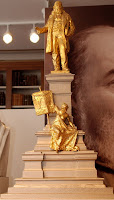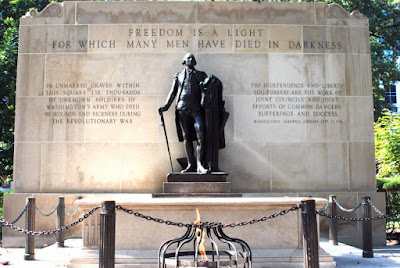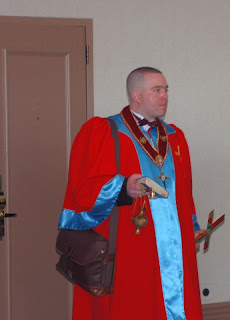
The altar in Supreme Council’s Temple Room room displays multiple VSLs. Made of black and gold marble, engraved into the front are the Hebrew letters that read: “God said, ‘Let there be Light’ and there was Light.”
Before another month passes, I had better resume Magpie coverage of Masonic Week 2009, but first a stop at the House of the Temple in Washington, DC. During a tour nearly two hours long, thanks to the indulgence of our guide, the Magpie Mason shot more than 100 photos. Herewith I share some of my favorites:

Bro. Jim, docent Kendall, and Grand Commander Ron.

Architect John Russell Pope’s columns.

I swear there was a dog outside
that was almost as big as this sphinx. Ask Jim!

You know they had to work 33 into the street address.
On the bicentennial of President Lincoln’s birthday, Bro. Jim Dillman of Logan Lodge in Indianapolis – a Board member of The Masonic Society, by the way – and I visited the headquarters of the Ancient & Accepted Scottish Rite, Southern Jurisdiction. This is the home of the “Mother Supreme Council,” the governing body of Scottish Rite that was established in Charleston, South Carolina on May 31, 1801.

In preparation for the bicentennial of Abraham Lincoln’s birth, the House of the Temple’s Library Reading Room displayed numerous images and books highlighting the 16th president. This statue caught my eye because it is a miniature of a famous statue very near Magpie headquarters. Sculpted by Bro. Gutzon Borglum, of Mt. Rushmore fame, it stands – or maybe sits – in Newark behind the old Essex County Courthouse.
The marvelous sites within this landmark structure truly are too numerous to list. Every Freemason, whether a Scottish Rite Mason or not, who visits DC should make some time to tour the House of the Temple. The architecture, statuary, stained glass, countless museum exhibits and stunning library demand hours of your attention. Hang around long enough and you’ll bump into Sovereign Grand Commander Ronald Seale or Brent Morris, the managing editor of the Scottish Rite Journal.

The East of the smaller (not subterranean) Supreme Council meeting room.

In the Temple Room.

There are many likenesses of Albert Pike in the House of the Temple. Left: a bust overlooks the Grand Staircase. Right: a Classical interpretation.
Above the staircase bust is the inscription: “What we have done for ourselves alone dies with us: What we have done for others and the world remains and is immortal.”


These are found in the Albert Pike Museum on the Ground Floor.

I'm sorry to say this photo fails to capture the effect of this beam of light entering the Grand Staircase. It was sublime.

Some of Pike’s A&ASR regalia.


A frequent chess player and occasional pipe smoker myself, I couldn’t help but notice these personal items owned by Albert Pike.




Aprons on exhibit.
Above: Master Mason.
Below: Rose Croix.


The Egyptian style statues at the foot of the Grand Staircase are representative of guards to a portal or entrance. Each is carved from a solid piece of marble quarried on the shores of Lake Champlain in New York state. Each statue carries a hieroglyphic inscription. Freely translated by the Metropolitan Museum of New York, they read: “Established to the Glory of God” and “Dedicated to the teaching of wisdom to those men working to make a strong nation.”(Caption courtesy of House of the Temple.)

Above: A wall in the Library Reading Room.
Below: Part of Pike’s personal library collection.


This is about 25 percent of the Robert Burns collection.
 Here is a collection of fountain pens once owned by Bro. Maurice Thatcher. (Yes, I sent a JPG to Cliff.) This gavel is made of pine once part of the White House, discarded during the reconstruction of the Executive Mansion after it was burned by the British during the War of 1812.
Here is a collection of fountain pens once owned by Bro. Maurice Thatcher. (Yes, I sent a JPG to Cliff.) This gavel is made of pine once part of the White House, discarded during the reconstruction of the Executive Mansion after it was burned by the British during the War of 1812.


Left: stained glass. Right: Hermes appears frequently in fixtures about the building.

Under glass, a copy of Anderson’s Constitutions.
Back when America had folk music, Bro. Burl Ives was a popular voice. Ives was a friend of Manly P. Hall and was well known about the apartments of Scottish Rite Masonry in California.


The Burl Ives Collection is surprisingly large!








































































































